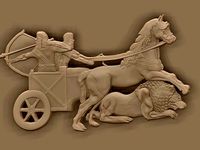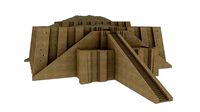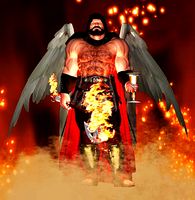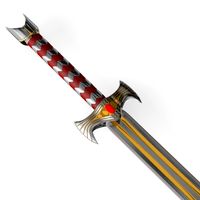CG Trader

Epic of Gilgamesh Enkidu -Assyrian king Ashurbanipal
by CG Trader
Last crawled date: 1 year, 6 months ago
Epic of Gilgamesh Enkidu ---
In this wall relief, the Assyrian King Ashurnasirpal II stands in a royal chariot and hunts lions. Neo-Assyrian era, 865-860 BCE. From Room B (the throne room), North-West palace at Nimrud (ancient Kalhu; Biblical Calah), northern Mesopotamia, Iraq. (The British Museum, London).
Menkaure statue pharaoh king of egypt 3dmodel for cnc and 3dprint
decor home accessories & decorative Wood engraving precision 3d model for cnc router buy for download file :)
* that 3d model for cnc router and 3d printer by Zbrush and Artcam software * **so We can do all the 3D models you want to do for cnc router. ****12 years experience in Z.brush & Art Cam Program. **95% of the details of the picture. It can be developed. Arrive as soon as possible. * Eng.Romany Hanna Graduate from Italian Institute of Istituto Salesiano Don Bosco for C.N.C . * for conection +201033963606 - +201286214941 so** we make online course check that link** :https://youtu.be/0xRdLI7xWpU thanks for like and review . story of them The Epic of Gilgamesh (/ˈɡɪlɡəmɛʃ/)[2] is an epic poem from ancient Mesopotamia, regarded as the earliest surviving notable literature and the second oldest religious text, after the Pyramid Texts. The literary history of Gilgamesh begins with five Sumerian poems about Bilgamesh (Sumerian for Gilgamesh), king of Uruk, dating from the Third Dynasty of Ur (c. 2100 BC).[1] These independent stories were later used as source material for a combined epic in Akkadian. The first surviving version of this combined epic, known as the Old Babylonian version, dates back to the 18th century BC and is titled after its incipit, Shūtur eli sharrī (Surpassing All Other Kings). Only a few tablets of it have survived. The later Standard Babylonian version compiled by Sîn-lēqi-unninni dates from the 13th to the 10th centuries BC and bears the incipit Sha naqba īmuru[note 1] (He who Saw the Abyss, in unmetaphoric terms: He who Sees the Unknown). Approximately two-thirds of this longer, twelve-tablet version have been recovered. Some of the best copies were discovered in the library ruins of the 7th-century BC Assyrian king Ashurbanipal. The first half of the story discusses Gilgamesh, king of Uruk, and Enkidu, a wild man created by the gods to stop Gilgamesh from oppressing the people of Uruk. After Enkidu becomes civilized through sexual initiation with Shamhat, he travels to Uruk, where he challenges Gilgamesh to a test of strength. Gilgamesh wins the contest; nonetheless, the two become friends. Together, they make a six-day journey to the legendary Cedar Forest, where they plan to slay the Guardian, Humbaba the Terrible, and cut down the sacred Cedar.[4] The goddess Ishtar sends the Bull of Heaven to punish Gilgamesh for spurning her advances. Gilgamesh and Enkidu kill the Bull of Heaven after which the gods decide to sentence Enkidu to death and kill him. In the second half of the epic, distress over Enkidu's death causes Gilgamesh to undertake a long and perilous journey to discover the secret of eternal life. He eventually learns that Life, which you look for, you will never find. For when the gods created man, they let death be his share, and life withheld in their own hands.[5][6] Nevertheless, because of his great building projects, his account of Siduri's advice, and what the immortal man Utnapishtim told him about the Great Flood, Gilgamesh's fame survived well after his death with expanding interest in the Gilgamesh story which has been translated into many languages and is featured in works of popular fiction. The epic is regarded as a foundational work in religion and the tradition of heroic sagas, with Gilgamesh forming the prototype for later heroes like Heracles (Hercules), and the epic itself serving as an influence for Homeric epics.[7] epic gilgamesh enkidu ashurbanipal iraq sumerian decortion culture woodcarved interior exterior 3dmodel cncrouter museum sculpture architectural history civilization art statue other
In this wall relief, the Assyrian King Ashurnasirpal II stands in a royal chariot and hunts lions. Neo-Assyrian era, 865-860 BCE. From Room B (the throne room), North-West palace at Nimrud (ancient Kalhu; Biblical Calah), northern Mesopotamia, Iraq. (The British Museum, London).
Menkaure statue pharaoh king of egypt 3dmodel for cnc and 3dprint
decor home accessories & decorative Wood engraving precision 3d model for cnc router buy for download file :)
* that 3d model for cnc router and 3d printer by Zbrush and Artcam software * **so We can do all the 3D models you want to do for cnc router. ****12 years experience in Z.brush & Art Cam Program. **95% of the details of the picture. It can be developed. Arrive as soon as possible. * Eng.Romany Hanna Graduate from Italian Institute of Istituto Salesiano Don Bosco for C.N.C . * for conection +201033963606 - +201286214941 so** we make online course check that link** :https://youtu.be/0xRdLI7xWpU thanks for like and review . story of them The Epic of Gilgamesh (/ˈɡɪlɡəmɛʃ/)[2] is an epic poem from ancient Mesopotamia, regarded as the earliest surviving notable literature and the second oldest religious text, after the Pyramid Texts. The literary history of Gilgamesh begins with five Sumerian poems about Bilgamesh (Sumerian for Gilgamesh), king of Uruk, dating from the Third Dynasty of Ur (c. 2100 BC).[1] These independent stories were later used as source material for a combined epic in Akkadian. The first surviving version of this combined epic, known as the Old Babylonian version, dates back to the 18th century BC and is titled after its incipit, Shūtur eli sharrī (Surpassing All Other Kings). Only a few tablets of it have survived. The later Standard Babylonian version compiled by Sîn-lēqi-unninni dates from the 13th to the 10th centuries BC and bears the incipit Sha naqba īmuru[note 1] (He who Saw the Abyss, in unmetaphoric terms: He who Sees the Unknown). Approximately two-thirds of this longer, twelve-tablet version have been recovered. Some of the best copies were discovered in the library ruins of the 7th-century BC Assyrian king Ashurbanipal. The first half of the story discusses Gilgamesh, king of Uruk, and Enkidu, a wild man created by the gods to stop Gilgamesh from oppressing the people of Uruk. After Enkidu becomes civilized through sexual initiation with Shamhat, he travels to Uruk, where he challenges Gilgamesh to a test of strength. Gilgamesh wins the contest; nonetheless, the two become friends. Together, they make a six-day journey to the legendary Cedar Forest, where they plan to slay the Guardian, Humbaba the Terrible, and cut down the sacred Cedar.[4] The goddess Ishtar sends the Bull of Heaven to punish Gilgamesh for spurning her advances. Gilgamesh and Enkidu kill the Bull of Heaven after which the gods decide to sentence Enkidu to death and kill him. In the second half of the epic, distress over Enkidu's death causes Gilgamesh to undertake a long and perilous journey to discover the secret of eternal life. He eventually learns that Life, which you look for, you will never find. For when the gods created man, they let death be his share, and life withheld in their own hands.[5][6] Nevertheless, because of his great building projects, his account of Siduri's advice, and what the immortal man Utnapishtim told him about the Great Flood, Gilgamesh's fame survived well after his death with expanding interest in the Gilgamesh story which has been translated into many languages and is featured in works of popular fiction. The epic is regarded as a foundational work in religion and the tradition of heroic sagas, with Gilgamesh forming the prototype for later heroes like Heracles (Hercules), and the epic itself serving as an influence for Homeric epics.[7] epic gilgamesh enkidu ashurbanipal iraq sumerian decortion culture woodcarved interior exterior 3dmodel cncrouter museum sculpture architectural history civilization art statue other
Similar models
thingiverse
free

Ashurbanipal | King Of The World by Ali_Alghadhbawi
.... ashurbanipal's library is the primary reason why texts such as the epic of gilgamesh managed to survive to the present day.
cg_trader
$40

Ashurbanipal | 3D
... assyrian descent california assyrian king lamassu lion king enkidu hero ancient mesopotamian sargon nineveh miniatures figurines
3dwarehouse
free

Ziggurat of Marduk
...t #pyramid #religion #sacrifice #step #steppyramid #sumer #sumerian #temenanki #temple #tower #uruk #worship #ziggurat #ziggurats
cg_trader
$33

Ashurbanipal lion hunt Lion Hunt - Assyrian 3dmodel for CNC
...rian relief 3dmodel 3dprint iraq horse achaemenid nimrud king british museum sculpture architectural culture history statue other
cg_trader
$1000

Warka Vase | 3D
...periods, from the site of göbekli tepe, dating to circa 9000 bc. warka uruk vase sumerian godddess iraq egypt sculpture art other
cg_trader
$3

HAMMURABI statue - 3d print | 3D
..., the king of assyria, and forced his son mut-ashkur to pay tribute, bringing almost all of mesopotamia under babylonian rule.[3]
3dwarehouse
free

Sumerian City
...sopotamia #mesopotamian #mountain #nebuchadnezzar #polytheism #pyramid #ramp #sumer #sumerian #temple #tigris #town #ur #ziggurat
3dwarehouse
free

Etemenanki Tower - Babylonian dynasty 6th-century BCE
...riologist george smith, it gives the height of the tower as seven stocks (91 meters) with a square base of 91 meters on each side
cg_trader
$23

Ziggurat Ur of Iraq
...ctanerender 3d model ziggurat ur nasiriyah sumerians babylonians iraq milestones civilization exterior historic historic exterior
3dwarehouse
free

Babylon
...buildings and debris. #babylon, #buildings, #castle, #city, #euphrates #gate, #mesopotamia, #palace, #rivers, #tigris, #ziggurat,
Ashurbanipal
thingiverse
free

Ashurbanipal | King Of The World by Ali_Alghadhbawi
.... ashurbanipal's library is the primary reason why texts such as the epic of gilgamesh managed to survive to the present day.
cg_trader
$40

Ashurbanipal | 3D
... assyrian descent california assyrian king lamassu lion king enkidu hero ancient mesopotamian sargon nineveh miniatures figurines
cg_trader
$33

Ashurbanipal lion hunt Lion Hunt - Assyrian 3dmodel for CNC
...rian relief 3dmodel 3dprint iraq horse achaemenid nimrud king british museum sculpture architectural culture history statue other
cg_trader
$18

Geometry Pendant amulet Flower of Life | 3D
...that were once part of the palace of king ashurbanipal and date back to 645 bc. e. pendant diamond...
cg_trader
$19

Geometry Pendant amulet Flower of Life 3D print model 438 | 3D
...that were once part of the palace of king ashurbanipal and date back to 645 bc. e. viking necklace///...
cg_trader
$19

Geometry Pendant amulet Flower of Life 3D print model 438 | 3D
...that were once part of the palace of king ashurbanipal and date back to 645 bc. e. viking necklace///...
cg_trader
$18

Geometry Pendant amulet Flower of Life 438 | 3D
...that were once part of the palace of king ashurbanipal and date back to 645 bc. e. viking necklace///...
Gilgamesh
thingiverse
free

Gilgamesh construct - dnd
...gilgamesh construct - dnd
thingiverse
gilgamesh construct - dnd
thingiverse
free

Gilgamesh / Necklace + Bracelet
...for the bracelet pieces.
i used maya to make these and i have no experience using it, so the holes didn't turn out very good.
blendswap
free

BlenRig4 Gilgamesh
.../tube.freefac.org)fully rigged model[http://www.jpbouza.com.ar](http://www.jpbouza.com.ar)creative commons attribution-sharealike
blendswap
free

BlenRig 4.01 - Gilgamesh
...position of master_torso bone so that it matches the actual center of gravity of the modelcreative commons attribution-sharealike
thingiverse
free

Missile Battery Turret for Gilgamesh Battle Tank (15mm scale) by dutchmogul
...growing catalog of gaming miniatures that you can use for whatever you want! (psst... we take requests and commissions...)
enjoy!
thingiverse
free

Gilgamesh Pattern Battle Tank (15mm scale) by dutchmogul
...growing catalog of gaming miniatures that you can use for whatever you want! (psst... we take requests and commissions...)
enjoy!
thingiverse
free

Gilgamesh Pattern Battle Tank (18mm scale) by dutchmogul
...ssions...)
also, you can find and hack the model on tinkercad. post pics if you make a variant or design some accessories!
enjoy!
thingiverse
free

Ashurbanipal | King Of The World by Ali_Alghadhbawi
...primary reason why texts such as the epic of gilgamesh managed to survive to the present...
renderosity
$8

Trailer Music Pack
...(1:06)<br /> 04 - apocalypto (0:56)<br /> 05 - gilgamesh (3:25)<br /> 06 - the power (0:53)<br /> 07...
cults
free

Gilgamesh Pattern Battle Tank (18mm scale)
...mesh pattern battle tank (18mm scale)
cults
gilgamesh pattern battle tank (18mm scale)
gilgamesh pattern battle tank (18mm scale)
Assyrian
turbosquid
$10

Chariot - Assyrian
...- assyrian for download as 3ds, lwo, obj, blend, dae, and stl on turbosquid: 3d models for games, architecture, videos. (1349636)
turbosquid
$150

ASSYRIAN STATUE - BLESSING GENIE
...essing genie for download as 3ds, dae, fbx, obj, stl, and wrl on turbosquid: 3d models for games, architecture, videos. (1639021)
3d_export
$83

Assyrian bas relief sculpture centaur 3D Model
...e ancient design decorative art centaur max 3ds v-ray fbx
assyrian bas relief sculpture centaur 3d model butterfly 28184 3dexport
cg_studio
$75

Assyrian bas relief sculpture centaur3d model
....obj .fbx .3ds - assyrian bas relief sculpture centaur 3d model, royalty free license available, instant download after purchase.
3d_export
$5

human-headed winged lion
...human-headed winged lion 3dexport assyrian human-headed winged lion 3d model. real-time ready, multiple import...
thingiverse
free

Assyrian Relief 3D Scan by 3DWP
...he museum of fine arts in boston.
the original is here: http://www.123dapp.com/catch/assyrian-relief/3894234
http://www.3dwp.nl
thingiverse
free

Assyrian Palace by StandardOfUr
...s just so that some details can show on such a small scale in the 3d print. i may come back and update this design in the future.
renderosity
$15

dForce Assyrian Outfit for Genesis 8 Female
...gt;
<br />
requires dforce for fitting, contains no separate fit morphs other than the generic expandall option.</p>
thingiverse
free

Montini Assyrian Winged Bull Wall Set (Lego Compatible) by leftspin
...very quickly.
i would love to see your make!
original art scan by caz egelie:
www.myminifactory.com/object/3d-print-lamassu-28697
thingiverse
free

Lamassu by mustafa21
...winged also called shiddo to amoussou as mentioned in assyrian inscriptions and the origin of the word "to amaso"...
Epic
3d_ocean
$29

Epic God
... hand. in his left hand he holds a cup. the archive contains: universal 3d file format (.obj) image preview. *the texture of f...
3d_ocean
$10

Epic Swords
... for unity3d (3.5v and up) + ready to use unity3d package epic names, for epic swords! use them to cut-off enemies heads! just...
turbosquid
$15

Epic Sword
...bosquid
royalty free 3d model epic sword for download as fbx on turbosquid: 3d models for games, architecture, videos. (1220458)
turbosquid
$10

Epic Swords
... available on turbo squid, the world's leading provider of digital 3d models for visualization, films, television, and games.
turbosquid
$10

epic sword
... available on turbo squid, the world's leading provider of digital 3d models for visualization, films, television, and games.
3d_export
$5

Epic Sword 3D Model
...epic sword 3d model
3dexport
sword
epic sword 3d model kolka 6778 3dexport
turbosquid
$39

EPIC WIN Bible
...ree 3d model epic win bible for download as obj, dwg, and 3ds on turbosquid: 3d models for games, architecture, videos. (1535493)
turbosquid
$5

Epic Bastard Sword
... model epic bastard sword for download as blend, fbx, and obj on turbosquid: 3d models for games, architecture, videos. (1669456)
turbosquid
$7

EPIC TABLE LAMP
... model epic table lamp for download as 3ds, max, obj, and fbx on turbosquid: 3d models for games, architecture, videos. (1475357)
3d_export
$5

Epic Sword 3D Model
...y epic низкополигональный good fbx
epic sword 3d model download .c4d .max .obj .fbx .ma .lwo .3ds .3dm .stl kexer 107168 3dexport
King
3ddd
$1

King
...king
3ddd
панель
гипсовая стеновая панель. модель king.
3ddd
$1

KING
...king
3ddd
напольный светильник king
цвет: красный, белый, черный
материал: ткань, стекловолокно
design_connected
$11

King
...king
designconnected
autoban king floor lights computer generated 3d model. designed by seyhan özdemir.
3d_ocean
$5

Kings Sword
...kings sword
3docean
king melee one handed swowd weapon
kings sword.
3d_export
$5

the sword of king ererk the fictional king
...the sword of king ererk the fictional king
3dexport
a simple model of the one-and-a-half sword of king ererk
3d_export
$15

king kong
...king kong
3dexport
king kong
3d_export
$12

chess king
...chess king
3dexport
a chess king
3ddd
$1

cosmo KING
...cosmo king
3ddd
cosmo king
turbosquid
$4

King
...ng
turbosquid
royalty free 3d model king for download as stl on turbosquid: 3d models for games, architecture, videos. (1272597)
3ddd
$1

Кровать KING
...кровать king
3ddd
king
просто кровать
